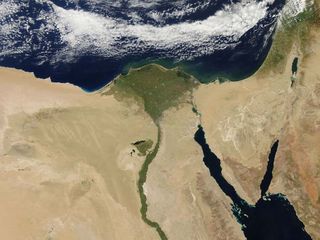The Nile: Longest River in the World

The Nile River, considered the longest river in the world, is approximately 4,258 miles (6,853 kilometers) long, but its exact length is a matter of debate. Flowing northward through the tropical climate of eastern Africa and into the Mediterranean Sea, the river passes through 11 countries: Tanzania, Uganda, Rwanda, Burundi, the Democratic Republic of the Congo, Kenya, Ethiopia, Eritrea, South Sudan, Sudan and Egypt.
The Nile has two major tributaries: the longer White Nile, considered the prime stream and headwaters; and the Blue Nile, which carries about two-thirds of the river's water volume and most of the silt.
The White Nile begins at Lake Victoria, Africa's largest lake, which touches the countries of Uganda, Kenya and Tanzania. But Lake Victoria isn't necessarily the most distant and "true" source of the Nile River because the lake itself has many feeder rivers coming in from the surrounding mountains. In 2006, a British explorer named Neil McGrigor said he'd traveled to the Nile's most distant source at the beginning of the Kagera River, Lake Victoria's longest feeder river.
Still, experts do not agree which tributary of the Kagera is the longest — and therefore the most distant — source of the Nile. Ultimately, it would be either the Ruvyironza in Burundi or the Nyabarongo from the Nyungwe Forest in Rwanda.
Much less disputable is the Blue Nile's source at Lake Tana in Ethiopia. The Blue Nile meets up with the White Nile near Sudan's capital city, Khartoum. From there, the river flows north through the desert in Egypt, and finally, by way of a large delta, the Nile flows into the Mediterranean Sea.
The Nile Delta
The Nile waters flow at an average volume of 300 million cubic meters (79.2 billion gallons) per day, according to Travelling Along Rivers, a Dutch bilingual travel magazine. It takes approximately three months for the waters near the town of Jinja, Uganda (the point where the Nile leaves Lake Victoria), to reach the Mediterranean Sea.
The Nile Delta is approximately 100 miles (161 km) long from north to south, and it spreads out along about 150 miles (241 km) of Egyptian coastline, from Alexandria in the west to Port Said in the east. It is one of the world's largest river deltas with about 40 million inhabitants — approximately half of Egypt's population. Just before reaching the Mediterranean Sea, the river splits into two main branches, the Rosetta Branch (to the west) and the Damietta (to the east).
Ancient mythology of the Nile
Perhaps no river on Earth has captured the human imagination quite like the Nile River. From stories of Pharaohs and man-eating crocodiles to the discovery of the Rosetta stone, it was here, along the river's fertile banks, that one of the world's most remarkable civilizations — Ancient Egypt — was born around 3000 B.C. The Nile was not only the source of life for the ancient Egyptians, but is still so today for the millions of people living along its banks.
Known as both the "Father of Life" and the "Mother of All Men," the Nile was the center of life in Ancient Egypt. In the ancient Egyptian language, the Nile was called Ḥ'pī or Iteru, meaning "river." The Ancient Egyptians also called the river Ar or Aur, which means "black," in reference to the black silt left behind after the yearly flooding.
The Nile River was central to the Ancient Egyptians rise to wealth and power. Since rainfall is almost non-existent in Egypt, the Nile River and its yearly floodwaters offered the people a fertile oasis for rich agriculture.
The Nile is associated with many gods and goddesses, all of whom the Egyptians believed were deeply intertwined with the blessings and curses of the land, weather, culture and abundance of the people. They believed the gods were intimately involved with the people and could help them in all facets of their lives.
In some myths, the Nile was considered a manifestation of the god Hapi who blessed the land with abundance, according to the Ancient History Encyclopedia. Isis, the goddess of the Nile and the "Giver of Life," was believed to have taught the people how to farm and work the land.
The water god Khnum, who ruled over all forms of water, even the lakes and rivers in the underworld, was believed to be in charge of the amount of silt that flooded the river banks every year. In later dynasties, Khnum branched out to become the god of rebirth and creation as well.
Flooding
Each year, heavy summer rains upstream and melting snow in the Ethiopian Mountains would fill the Blue Nile well over its capacity and send a torrent of water downstream. The extra water would then spill over the banks onto the dry desert land of Egypt. Once the floods subsided, thick black silt, or mud, would be left behind on the ground. The silt created rich, fertile soil for planting crops — vital in this land of so little rain. Approximately 96 percent of the sediment carried by the Nile River originates in Ethiopia, according to the New World Encyclopedia. The silt area was known as the Black Land, while the desert lands further out were known as the Red Land.
Each year, the Ancient Egyptian people eagerly awaited and thanked the gods for the life-giving floods. If the floods were too small, there would be difficult times ahead with little food. If the floods were too large, it could cause flooding harm in the surrounding villages.
The Egyptian calendar was divided into three stages based on the yearly flood cycle: Akhet, the first season of the year, which covered the flooding period between June and September; Peret, the growing and sowing time from October to mid-February; and Shemu, the time of harvesting between mid-February and the end of May.
In 1970, the Aswan High Dam was built in Egypt to help regulate the Nile's flooding. Although the floods were desperately needed in older times, they are less necessary and even a nuisance to modern civilization with its irrigation systems. Even though the floods no longer occur along the Nile, the memory of this fertile blessing is still celebrated in Egypt today, mainly as an entertainment for tourists. The annual celebration, known as Wafaa El-Nil, begins on August 15th and lasts for two weeks.
Sharing the Nile
Because 11 countries must share one precious resource, there are bound to be disputes. The Nile Basin Initiative (NBI), an intergovernmental partnership among all the Basin States, was formed in 1999. It offers a forum for discussion and coordination among the countries to help manage and share the river's resources.
Joseph Awange is an associate professor in the department of spatial sciences at Curtin University in Australia. Using satellites, he has been monitoring the volume of water in the Nile River and reporting the findings to the Basin countries so they can effectively plan for sustainable use of the river's resources.
Of course, getting all the countries to agree on what they believe is fair and equal use of the Nile's resources is no easy task. "Lower countries (Egypt and Sudan) rely on some old treaty that they signed with Britain decades ago to impose unrealistic water use conditions to the upper countries," said Awange. "For this reason, some countries, e.g., Ethiopia, have decided to disregard the treaty and are busy constructing large hydropower dams within the Blue Nile."
Awange is referring to the Grand Ethiopian Renaissance Dam (GERD), currently under construction on the Blue Nile. It is located just over 300 miles northwest of Ethiopia's capital, Addis Ababa. When complete, the GERD will be the largest hydroelectric dam in Africa and one of the largest in the world. Controversy has surrounded the project since its beginning in 2011 as downstream nations rely heavily on the Nile's waters for their drinking water, agriculture and industrial needs.
Wildlife
The Nile River and its banks are abundant with many varieties of animal life. These include the rhinoceros, African tigerfish (the "piranha of Africa"), Nile monitors, enormous Vundu catfish, hippopotamuses, wildebeests, baboons, frogs, mongooses, turtles, tortoises and over 300 species of birds. Hundreds of thousands of water birds spend their winters in the Nile Delta. This includes the world's largest concentrations of little gulls and whiskered terns.
Possibly the most well-known animal — and most feared — is the Nile crocodile. This fearsome predator has a reputation as a man eater and rightly so. Nile crocodiles can reach lengths of 18 to 20 feet, and unlike their American cousins, can be quite aggressive toward people. Estimates say that about 200 people a year are killed by these reptiles, according to National Geographic.
Additional resources
Sign up for the Live Science daily newsletter now
Get the world’s most fascinating discoveries delivered straight to your inbox.

